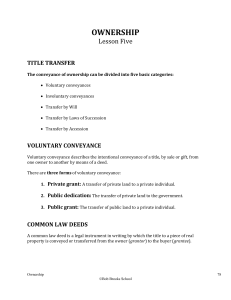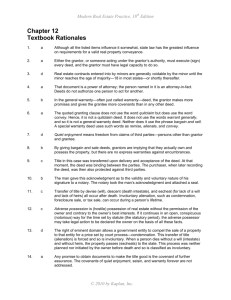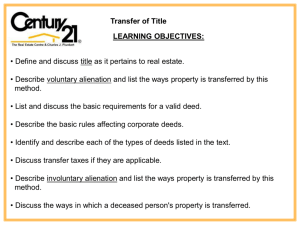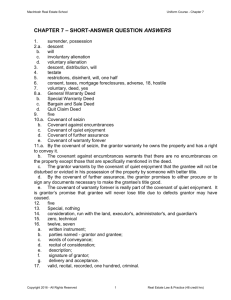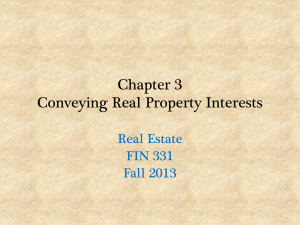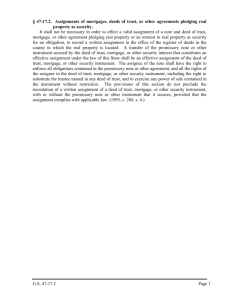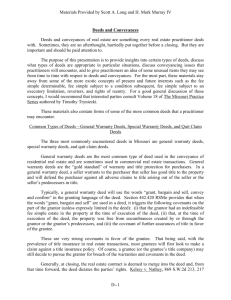Lecture Outline
advertisement
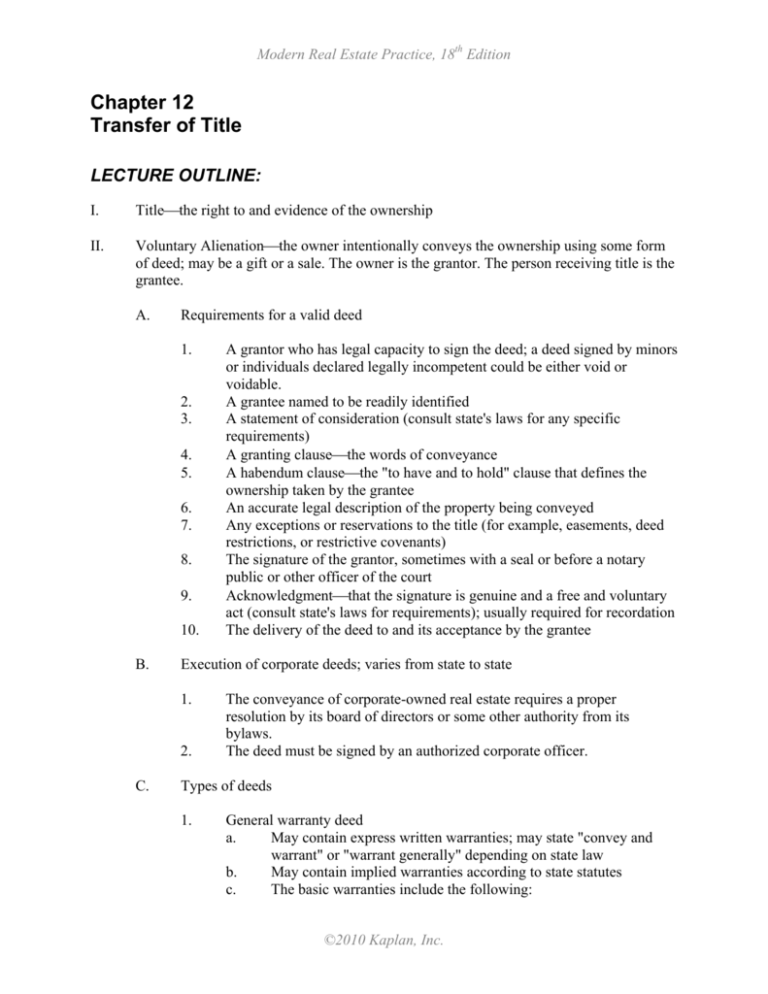
Modern Real Estate Practice, 18th Edition Chapter 12 Transfer of Title LECTURE OUTLINE: I. Title⎯the right to and evidence of the ownership II. Voluntary Alienation⎯the owner intentionally conveys the ownership using some form of deed; may be a gift or a sale. The owner is the grantor. The person receiving title is the grantee. A. Requirements for a valid deed 1. 2. 3. 4. 5. 6. 7. 8. 9. 10. B. Execution of corporate deeds; varies from state to state 1. 2. C. A grantor who has legal capacity to sign the deed; a deed signed by minors or individuals declared legally incompetent could be either void or voidable. A grantee named to be readily identified A statement of consideration (consult state's laws for any specific requirements) A granting clause⎯the words of conveyance A habendum clause⎯the "to have and to hold" clause that defines the ownership taken by the grantee An accurate legal description of the property being conveyed Any exceptions or reservations to the title (for example, easements, deed restrictions, or restrictive covenants) The signature of the grantor, sometimes with a seal or before a notary public or other officer of the court Acknowledgment⎯that the signature is genuine and a free and voluntary act (consult state's laws for requirements); usually required for recordation The delivery of the deed to and its acceptance by the grantee The conveyance of corporate-owned real estate requires a proper resolution by its board of directors or some other authority from its bylaws. The deed must be signed by an authorized corporate officer. Types of deeds 1. General warranty deed a. May contain express written warranties; may state "convey and warrant" or "warrant generally" depending on state law b. May contain implied warranties according to state statutes c. The basic warranties include the following: ©2010 Kaplan, Inc. Modern Real Estate Practice, 18th Edition (1) (2) (3) (4) (5) d. 2. c. d. b. c. f. 6. 7. May state "grants and releases" or "grants, bargains, and sells" in the document, depending on state law Contains no warranties against encumbrances unless stated Only implies that the grantor holds title and possession Quitclaim deed a. b. c. d. e. 5. Contains clause "remise, release, alienate, and convey" Warrants only that the title was not encumbered while the grantor held it except as noted in the deed. Any additional warranties must be specifically stated in the deed. May be used by a fiduciary Bargain and sale deed a. 4. Grantor defends title against both the grantor and against all those who previously held title. Special warranty deed a. b. 3. The covenant of seisin—the owner has full ownership and the legal right to convey the title The covenant against encumbrances—the title is free from all liens and encumbrances except those specifically stated The covenant of quiet enjoyment—the grantor assumes responsibility for protecting the title against the claims of third parties The covenant of further assurance—the grantor will furnish whatever is needed to make the title good The covenant of warranty forever—the grantor is liable for reimbursing the grantee for any title interest lost in the future Provides the least protection to the grantee Carries no covenants or warranties whatsoever Transfers only what interest the grantor may have, if any May state "remises, releases, and quitclaims" May be used to transfer a right or interest in real estate, such as an easement Often used to cure a defect in title (“cloud on the title”) Deed of trust (see Figure 12.1)—used by a trustor to convey property to a trustee for the benefit of a beneficiary Reconveyance deed—executed by the trustee to return (reconvey) title property held in trust to the trustor Trustee's deed ©2010 Kaplan, Inc. Modern Real Estate Practice, 18th Edition a. b. 8. Deed executed pursuant to a court order a. b. c. d. D. Usually a statutory deed form used to convey title Includes executor's deeds, administrator's deeds, sheriff's deeds, and others Used to convey title to property transferred by court order or by will The full consideration paid is usually stated on the deed. Transfer tax stamps 1. 2. 3. 4. 5. 6. Usually payable when the deed is recorded Paid by the seller, buyer, or split, depending on local custom or law Collected by some states, counties, or cities Rates vary from one jurisdiction to another. Some jurisdictions use a transfer declaration form, transfer statement, or affidavit of real property value as basis for calculating tax. Some deeds are exempted from the tax, such as the following: a. b. c. d. e. f. g. h. i. 7. III. Used to convey property out of a trust to anyone other than the trustor Executed by the authority granted to the trustee Gifts Deeds not made in connection with a sale Conveyances to or between government bodies Deeds by charitable, religious, or educational institutions Deeds securing debts or releasing property as security for a debt Partitions Tax deeds Deeds pursuant to mergers of corporations Deeds from subsidiary to parent corporations for cancellation of stock Math Concept: Calculating transfer taxes Involuntary Alienation⎯transfers without the owner's consent (see Figure 12.2) A. Transfer by operation of law 1. 2. 3. Eminent domain (through condemnation) Escheat Any type of foreclosure; for example, delinquent real estate taxes or special assessments, mortgage, or deed of trust laws ©2010 Kaplan, Inc. Modern Real Estate Practice, 18th Edition B. Transfer by natural forces (see Chapter 7)—such as earthquakes, hurricanes, sinkholes, and mudslides C. Transfer by adverse possession 1. 2. 3. IV. Possession by the trespasser must be open, notorious, continuous for a statutory number of years, and hostile. Tacking permits combining successive periods of adverse possession by different persons. Each jurisdiction has its own minimum requirements before an adverse possession claim can be filed. Conveyance of a Deceased Person's Property A. Transfer of title by will⎯a devise; the person dies testate 1. 2. 3. 4. A will is a testamentary instrument that becomes effective only after the death of its maker. It must strictly adhere to the laws of the state. It cannot supersede dower and curtesy laws (where they apply) Requirements for a valid will a. b. c. d. 5. 6. 7. 8. B. A codicil is a modification of or an amendment to a will. A holographic will is in its maker's own handwriting. A nuncupative will is given verbally by its maker. Some states do not permit property to be conveyed by oral or handwritten wills. Transfer of title by descent⎯the laws of the state determine to whom ownership passes; the person dies intestate (see Table 12.2) 1. 2. 3. C. The maker (the testator) must be of legal age. The testator must be of sound mind. It must be a free and voluntary act; the maker must be under no undue influence. The signing of the will must be witnessed by two or more persons in most states The laws of intestate succession vary from state to state. Generally, there are primary heirs (spouse, children). The closeness of one's relationship to the deceased determines the amount of the estate that will be received. Probate proceedings⎯the purpose is to see that assets are distributed properly; affects only those assets that do not otherwise distribute themselves by their title. ©2010 Kaplan, Inc. Modern Real Estate Practice, 18th Edition 1. It is a legal process that completes the following: a. b. c. d. 2. 3. 4. 5. Proves or confirms the validity of the will Determines the precise assets of the deceased person Identifies the people to whom the assets are to pass Takes place in the county where the decedent resided An administrator is appointed if there is no will designating an executor, sometimes referred to as "personal representatives." Legal procedures vary considerably from state to state. The decedent's debts must be satisfied before any property can be disbursed to the devisees or heirs. In Practice: Commissions on properties listed through probate are fixed by the court and paid only after the sale has been approved by the court ©2010 Kaplan, Inc.
